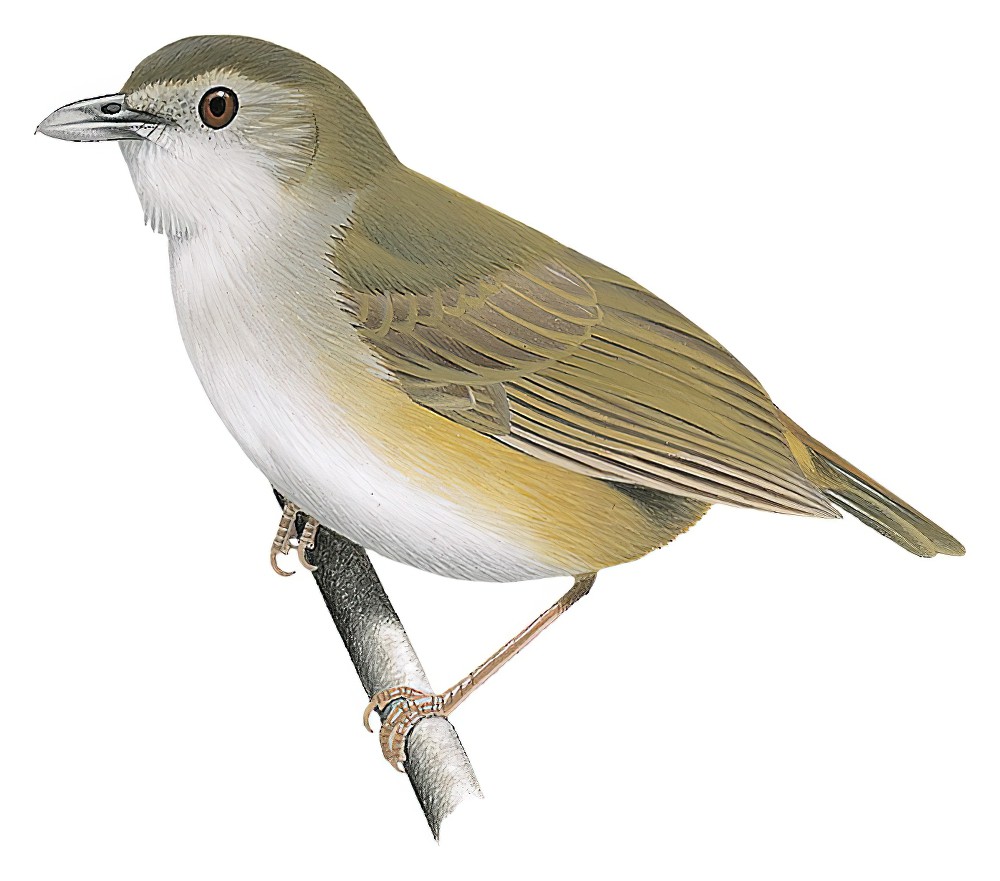Horsfield’s Babbler / Turdinus sepiarius

Horsfield's Babbler
SCI Name:
Protonym: Brachypteryx sepiaria Trans.Linn.Soc.London(1), 13 p.158
Taxonomy: Passeriformes / Pellorneidae / Turdinus
Taxonomy Code: horbab2
Type Locality: Java; here restricted to Bogor [lat. 6° 36'' S., long. 106° 48'' E.].
Author: Horsfield
Publish Year: 1821
IUCN Status: Least Concern
DEFINITIONS
TURDINUS
(Pellorneidae; Ϯ Large Wren-babbler T. macrodactylus) Mod. L. turdinus thrush-like < L. turdus thrush; "Macronous ... Next to it, I had arranged a bird which has recently been described by Mr. Strickland by the name Malacopteron macrodactylum (Ann. and Mag. Nat. Hist. 1844, p. 417), but I still consider it to merit separation, from the general robustness of its conformation, and the great strength of the tarse and of the middle and hind toes. The bill closely resembles that of Macronous. I designate it Turdinus, Nobis. Form somewhat Meruline, thick-set, with large strong legs and toes, and rounded wings and tail. Bill as long as the head, moderately stout, straight, compressed, the ridge of the upper mandible angulated, its tip emarginated, and curving over that of the lower mandible; nostrils oval, and pierced in the fore-part of the nasal membrane, at some distance from the frontal feathers; rictus well armed: legs stout, the tarse equalling the middle toe with its claw; outer and inner toes equal, and proportionally small, their terminal joint reaching only to the penultimate joint of the middle toe; hind toe strong, and furnished with a rather large claw, but moderately curved: wings much graduated, the fifth to the ninth primaries inclusive subequal and longest, the first about half their length; tail also graduated externally, and hollowed underneath; plumage lax and scale-like, at least on the upper-parts, very copious and puffy over the rump. T. macrodactylus, (Strickland) Blyth. ... Brought from Singapore." (Blyth 1844).
Synon. Cacopitta, Curzonia, Gypsophila, Hadropezus.
● See: Turdinulus
turdinus
Mod. L. turdinus thrush-like < L. turdus thrush (see turdina).
sepiaria / sepiarium / sepiarius
● L. sepes, sepis, or saepes, saepis hedge.
● Mod. L. sepiarius sepia-brown, reddish-brown, rich brown < Gr. σηπια sēpia cuttle-fish, sepia.
SUBSPECIES
Horsfield's Babbler (Hartert's)
SCI Name: Turdinus sepiarius tardinatus/barussanus
TURDINUS
(Pellorneidae; Ϯ Large Wren-babbler T. macrodactylus) Mod. L. turdinus thrush-like < L. turdus thrush; "Macronous ... Next to it, I had arranged a bird which has recently been described by Mr. Strickland by the name Malacopteron macrodactylum (Ann. and Mag. Nat. Hist. 1844, p. 417), but I still consider it to merit separation, from the general robustness of its conformation, and the great strength of the tarse and of the middle and hind toes. The bill closely resembles that of Macronous. I designate it Turdinus, Nobis. Form somewhat Meruline, thick-set, with large strong legs and toes, and rounded wings and tail. Bill as long as the head, moderately stout, straight, compressed, the ridge of the upper mandible angulated, its tip emarginated, and curving over that of the lower mandible; nostrils oval, and pierced in the fore-part of the nasal membrane, at some distance from the frontal feathers; rictus well armed: legs stout, the tarse equalling the middle toe with its claw; outer and inner toes equal, and proportionally small, their terminal joint reaching only to the penultimate joint of the middle toe; hind toe strong, and furnished with a rather large claw, but moderately curved: wings much graduated, the fifth to the ninth primaries inclusive subequal and longest, the first about half their length; tail also graduated externally, and hollowed underneath; plumage lax and scale-like, at least on the upper-parts, very copious and puffy over the rump. T. macrodactylus, (Strickland) Blyth. ... Brought from Singapore." (Blyth 1844).
Synon. Cacopitta, Curzonia, Gypsophila, Hadropezus.
● See: Turdinulus
Horsfield's Babbler (Horsfield's)
SCI Name: Turdinus sepiarius sepiarius
sepiaria / sepiarium / sepiarius
● L. sepes, sepis, or saepes, saepis hedge.
● Mod. L. sepiarius sepia-brown, reddish-brown, rich brown < Gr. σηπια sēpia cuttle-fish, sepia.
Horsfield's Babbler (Salvadori's)
SCI Name: Turdinus sepiarius rufiventris/harterti
TURDINUS
(Pellorneidae; Ϯ Large Wren-babbler T. macrodactylus) Mod. L. turdinus thrush-like < L. turdus thrush; "Macronous ... Next to it, I had arranged a bird which has recently been described by Mr. Strickland by the name Malacopteron macrodactylum (Ann. and Mag. Nat. Hist. 1844, p. 417), but I still consider it to merit separation, from the general robustness of its conformation, and the great strength of the tarse and of the middle and hind toes. The bill closely resembles that of Macronous. I designate it Turdinus, Nobis. Form somewhat Meruline, thick-set, with large strong legs and toes, and rounded wings and tail. Bill as long as the head, moderately stout, straight, compressed, the ridge of the upper mandible angulated, its tip emarginated, and curving over that of the lower mandible; nostrils oval, and pierced in the fore-part of the nasal membrane, at some distance from the frontal feathers; rictus well armed: legs stout, the tarse equalling the middle toe with its claw; outer and inner toes equal, and proportionally small, their terminal joint reaching only to the penultimate joint of the middle toe; hind toe strong, and furnished with a rather large claw, but moderately curved: wings much graduated, the fifth to the ninth primaries inclusive subequal and longest, the first about half their length; tail also graduated externally, and hollowed underneath; plumage lax and scale-like, at least on the upper-parts, very copious and puffy over the rump. T. macrodactylus, (Strickland) Blyth. ... Brought from Singapore." (Blyth 1844).
Synon. Cacopitta, Curzonia, Gypsophila, Hadropezus.
● See: Turdinulus
UPPERCASE: current genus
Uppercase first letter: generic synonym
● and ● See: generic homonyms
lowercase: species and subspecies
●: early names, variants, mispellings
‡: extinct
†: type species
Gr.: ancient Greek
L.: Latin
<: derived from
syn: synonym of
/: separates historical and modern geographic names
ex: based on
TL: type locality
OD: original diagnosis (genus) or original description (species)












